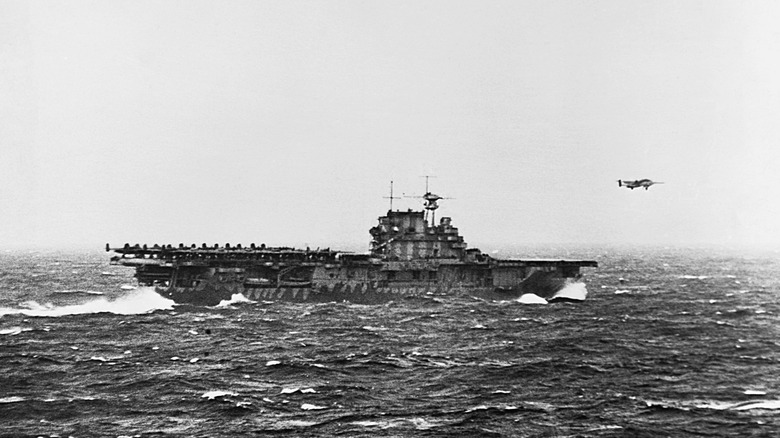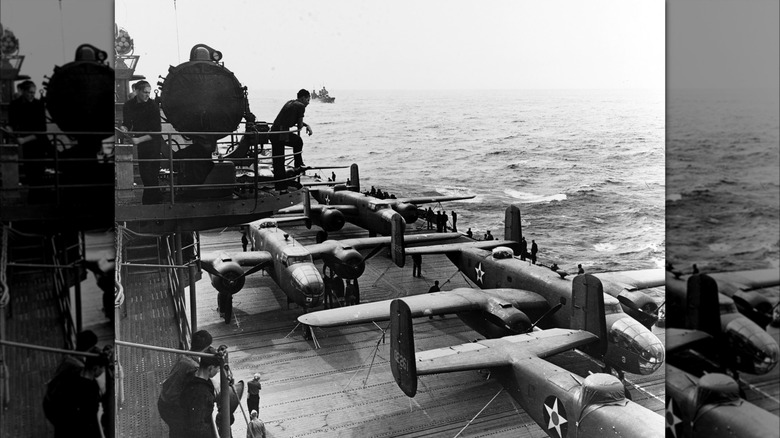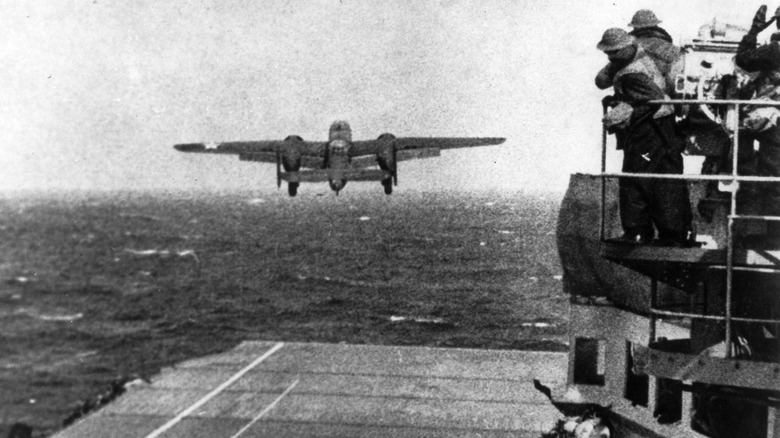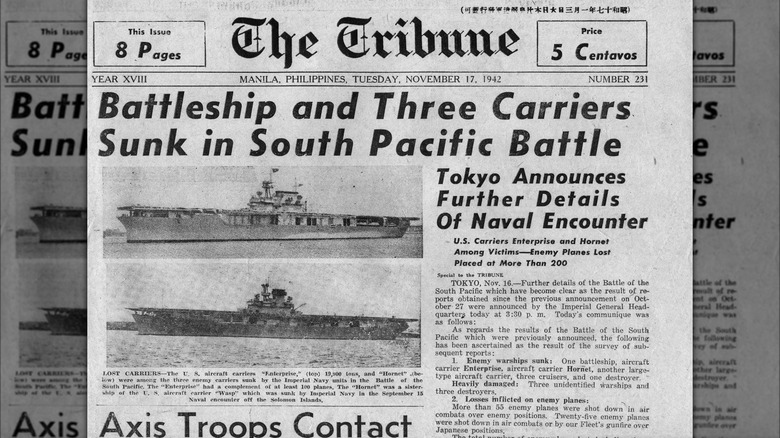
Historical/Getty Images
In the early morning hours of Sunday, December 7, 1941, a strike force of 353 aircraft from the Land of the Rising Sun poked the sleeping bear that was the United States by launching a sneak attack on the naval base at Pearl Harbor in Oahu, Hawaii, that left the Pacific Fleet a shambles.
Advertisement
In just one hour and 15 minutes, the Imperial Japanese Navy managed to kill 2,403 people, leaving another 1,178 wounded. The attack destroyed 169 planes and two battleships (the USS Arizona and the USS Oklahoma). On the flipside, Japanese forces only lost 129 military personnel, 29 planes, and five of its stealthy low profile «midget» submarines.
Fortunately for the Pacific Fleet, its aircraft carriers — USS Lexington (CV-2), USS Saratoga (CV-3), and USS Enterprise (CV-6) — weren’t in port, so the Japanese fleet couldn’t find them, leaving them unscathed. Before that date, the Navy had six operational aircraft carriers, with three others — USS Ranger (CV-4), USS Yorktown (CV-5), and USS Wasp (CV-7) — serving as part of the Atlantic Fleet.
Advertisement
The seventh aircraft carrier to enter service was the USS Hornet(CV-8), which was commissioned a mere 48 days before Pearl Harbor. It would eventually become famous for participating in a number of high-profile operations but also for having the shortest service life of any U.S. aircraft carrier.
The Doolittle Raid made the Hornet famous

Interim Archives/Getty Images
The Hornet was the final ship in the Yorktown class of carriers — limited in size by a series of treaties signed by the United States, United Kingdom, Japan, France, and Italy after World War I to prevent an arms race. One of those restrictions placed a maximum limit of 27,000 tons of displacement on battleships, battle cruisers, and aircraft carriers.
Advertisement
The Hornet’s construction began on Sept. 25, 1939, officially launched on Dec. 14, 1940, and was commissioned on October 20, 1941 in Norfolk, Virginia. Immediately following a cruise in January 1942, the Hornet was tasked with testing a plan developed by Lt. Col. James H. Doolittle that would, as Vice Chief of Naval Operations Admiral Bill Moran said, serve as «the first Americans to punch back at Japan, giving hope to the nation and the world when things looked bleakest.»
The plan was bold. Instead of sending a fleet of ships and aircraft in retaliation, it would sail one carrier with less than two dozen bombers to hit strategic targets and instill fear in Japan. In February 1942, while sitting off the coast of Virginia, a test was conducted wherein two Army Air Forces B-25 Mitchell bombers (one of the most notable planes in the Battle of the Pacific) successfully took off from the deck of the Hornet. However, landing them back on the carrier proved far too dangerous, and the plan was changed for the bombers to divert and land on the east coast of China.
Advertisement
It inspired America after its most infamous day

Mpi/Getty Images
The Hornet quickly set sail for the Naval Air Station (NAS) in Alameda, California, where it was loaded with 16 B-25s and their crews. On April 2, the troops headed for a rendezvous point approximately 600 miles east of Tokyo and met up with Vice Admiral William F. Halsey, Jr. aboard the aircraft carrier Enterprise (CV-6) ti become became part of Halsey’s Task Force 16. The mission was to get approximately 500 miles off the Japanese coast, then launch the attack.
Advertisement
On the morning of April 18, a Japanese picket boat spotted the task force, and Doolittle was forced to launch all 16 bombers. Despite still being some 650 miles away, the bombers successfully hit targets in Tokyo, Yokohama, Kobe, Yokosuka, and Nagoya. They even managed to hit and damage one of the Japanese fleet’s smaller aircraft carriers.
All but one of the bombers crashed either inside occupied China or along the coastline. While searching for the crews of the downed U.S. planes, the Japanese military carried out vicious attacks on the Chinese citizens. They eventually caught a handful of American airmen and executed three of them. One lone bomber made it to Vladivostok, Russia, where its crew was imprisoned.
Advertisement
The attack was a rousing success that inspired the American people and, according to Doolittle, «far exceeded our most optimistic expectations.» After the daring Doolittle Raid, the Hornet returned to Pearl Harbor for repairs and prepared for major combat.
The Hornet stung mightily at the Battle of Midway
Next, the Hornet was sent to the Coral Sea, where the first naval battle using only aircraft took place. In fact, the ships never saw each other. Unfortunately, the Hornet arrived too late and was unable to stop the Lexington from sinking or the Yorktown from sustaining heavy damage. The Hornet and Enterprise escorted the limping Yorktown back to Pearl Harbor.
Advertisement
On May 28, 1942, Task Force 16, which included the USS Hornet and USS Enterprise (one of many Naval ships to carry the name), left Pearl Harbor for Midway, joined by a repaired Yorktown later. The three carriers and their escorts clashed with Japanese forces at the Battle of Midway from June 3 to 6 and sunk four Japanese carriers. This battle proved to be a significant turning point in the war in the Pacific.
In October, the Japanese fleet attacked Guadalcanal to rid the U.S. fleet from the Solomon Islands once and for all. On Oct. 26, both the Hornet and the Enterprise were spotted by Japanese search planes as they sat north of the Santa Cruz Islands. Shortly, the Hornet was blasted by four bombs and two torpedoes, and if that wasn’t enough — two Aichi D3A2 «Val» dive bombers crashed directly into it.
Advertisement
[Featured image by U.S. Navy Naval Aviation News via Wikimedia Commons | Cropped and scaled | CC BY Public Domain]
The aircraft carrier that wouldn’t die

Interim Archives/Getty Images
The Enterprise also sustained severe damage, but the Hornet was in such bad shape that most of the crew was forced to abandon ship. A small group stayed behind, put out some fires, and made minor repairs, but the damage was too significant, and the Navy decided to scuttle her.
Advertisement
However, despite firing 16 torpedoes and 369 rounds of 5-inch shells into the Hornet, it wouldn’t sink. The coup de grace came later that evening when two Japanese destroyers (the Akigumo and Makigumo) fired four additional torpedoes into the Hornet, and she finally sank – hardly a year after being commissioned, making it the aircraft carrier with the shortest service life in the US Navy’s history.
During the battle, the Hornet only lost 111 lives from a crew of more than 2,00. The carrier crew received four battle stars during what Vice Chief of Naval Operations Admiral Bill Moran said was a short-lived but meteoric service. The USS Hornet (CV-8) was removed from the Naval Register on Jan. 13, 1943.
Advertisement
For decades after, the exact whereabouts of the Hornet were lost to history. However, in January 2019, the research team R/V Petrel (funded by the late Paul Allen, co-founder of Microsoft) found the USS Hornet sitting on the floor of the South Pacific Ocean at a depth of almost 17,500 feet (ranking as one of the deepest shipwrecks of WWII).